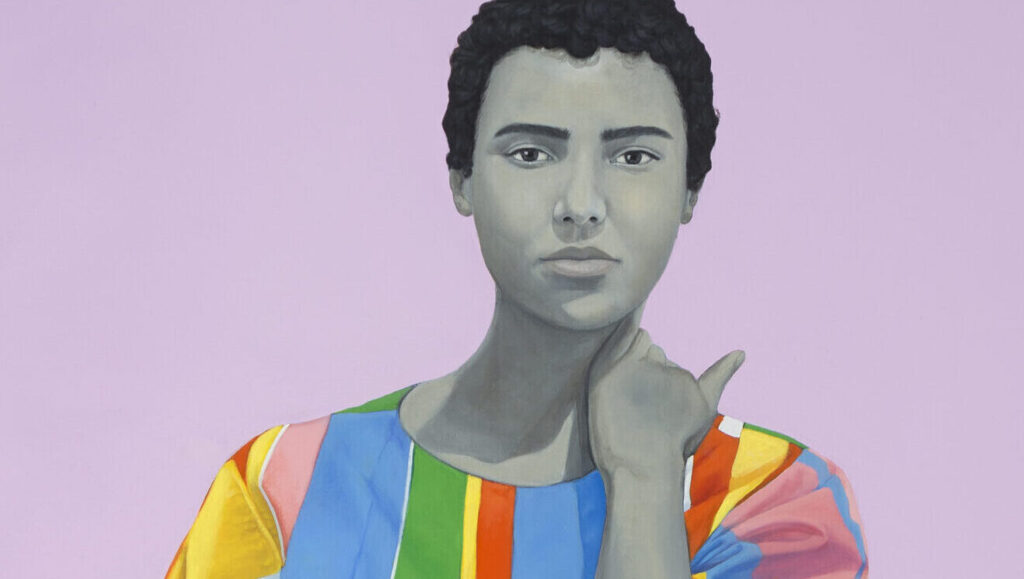The Time is Always Now (Exhibition)
Featuring 23 contemporary African diasporic artists, The Time Is Always Now: Artists Reframe the Black Figure celebrates the Black figure from the perspective of Black artists, illuminating the richness, joy, beauty, and complexity of Black life. In this resource, we will explore four writings featured in the exhibition and offer prompts to spark dialogue before, during, or after visiting.
James Baldwin and ‘The Time is Always Now’
The exhibition’s title is taken from a James Baldwin essay entitled “Faulkner and Desegregation” (1956) in which he writes,
“There is never a time in the future in which we will work out our salvation. The challenge is in the moment, the time is always now.”
Discussion Prompts
- What do you think James Baldwin means by “The time is always now”? Can you explain it in your own words?
Follow-up: Can you think of a situation in your life where waiting didn’t help and action ws needed right away?
- How do you think this quote connects to the idea of standing up for what’s right?
Follow-up: Are there times when people know what the right thing is, but wait too long to act?
- Imagine you see someone being treated unfairly at school. How could Baldwin’s quote inspire you to respond?
W.E.B. Du Bois and ‘Double Consciousness’
The second theme in the exhibition focuses on the idea of double consciousness. Artists in this section of the exhibition explore the aesthetic, psychological and political considerations involved in representing Blackness. The exhibition begins with the following quote:
“It is a peculiar sensation, this double-consciousness, this sense of always looking at one’s self through the eyes of others, of measuring one’s soul by the tape of a world that looks on in amused contempt and pity.” —W.E.B. Du Bois, Strivings of the Negro People, The Atlantic Monthly, 1897
Discussion Prompts
- What do you think Du Bois means by “looking at one’s self through the eyes of others”?
Follow-up: Have you ever felt like someone was judging you before getting to know you? What did that feel like?
- Why might it be difficult to “measure one’s soul” by how others see you, instead of how you see yourself?
Follow-up: Why is it important to know and define yourself from the inside?
- Can you think of a time when someone’s expectations or stereotypes didn’t match who you really are? How did that affect you?
bell hooks and ‘Past and Presence’
Another theme of the exhibition is ‘past and presence.’ The works in this section are concerned with the cannon of the Black representation in Western History of Art. They are concerned with proposing ways of looking at the past in order to establish a record that situates Black people at the center rather than periphery. The section includes the following quote:
“This ‘we’ is that us in the margins, that ‘we’ who inhabit marginal space that is not a site of domination but a place of resistance…. I am speaking from a place in the margins where I am different, where I see things differently. I am talking about what I see.” —bell hooks, 1989
Discussion Prompts
- What do you think bell hooks means when she says, “the margins… [are] not a site of domination but a place of resistance”?
Follow-up: How can being “different” or on the outside actually give someone a strong voice? - Why might someone who lives in the “margins” see things differently than people in the center of society?
Follow-up: Can you think of examples where people outside the mainstream have brought new ideas or change? - Have you ever felt like you were on the outside of a group or situation?
Kevin Quashie and ‘Our Aliveness’
The final theme of the exhibition is ‘Our Aliveness.’ Artists here conjure scenes of solidarity, kinship and ordinary joy in contrast to the popular prejudice that sites of Black gathering often fall under. This exhibition section begins with the following quote:
“Indeed, ‘imagine a black world’ is a love gesture that says to the one: Be as you are. You will become and you will undo. As you are, you are and are worthy – inhabit that and unfurl in and into the world.” —Kevin Quashie, 2021
Discussion prompts
- How does this quote make you feel about the idea of being yourself, just as you are?
- What does it mean to be “worthy” simply by being yourself—not because of what you do, but because of who you are?
- What do you think it means to “unfurl in and into the world”? How can someone grow, change, and still be true to who they are?
Additional Resources:
- Listen to this audio recordings on SoundCloud to hear from the curator and artists.
- Learn about the Marchioness by Ojih Odutola which is featured in the exhibition. The artist creates a series of portraits of fictional aristocratic Nigerian families and clans to imagine what life may be like for African people if colonization had not happened.
- Explore Vantage Point by Lorna Simpson who is featured artist in the exhibition.

